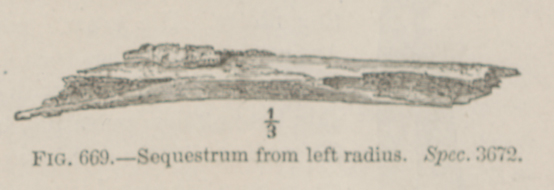Title: Hotz, R.
Source text: The Medical and Surgical History of the War of the Rebellion. (1861-65.), Part 2, Volume 2 (Washington, DC: Government Printing Office, 1876), 929.
Civil War Washington ID: med.d2e31316
TEI/XML: med.d2e31316.xml
CASE 1877.—Private R. Hotz, Co. I, 183d Pennsylvania, aged 29 years, was wounded at Cold Harbor, June 3, 1864, and admitted to the field hospital of the 1st division, Second Corps, where Surgeon W. S. Cooper, 125th New York, noted: "Gunshot wound of arm." On June 7th, the wounded man entered Harewood Hospital, Washington, and several days afterward he was transferred to Philadelphia. Surgeon L. Taylor, U. S. A., in charge of McClellan Hospital, made the following detailed report of the case: "He was wounded by a minié ball, which entered on the lower part of the posterior surface of the left forearm and came out immediately opposite the orifice of entrance, fracturing the radius, through which it passed. The patient was admitted to this hospital on June 13th, the lower wound being in a sloughing condition. It ceased sloughing by June 20th, and did well until July 1st, when the opening began again to increase in size. On July 28th, an abscess, pointing half way up the forearm, was opened; a probe introduced detected the presence of necrosed bone. The wound caused by the entrance of the ball had healed entirely about this time, while that of exit continued sloughing at intervals until September 1st, when it began to present a healthy appearance. It was now evident that a large portion of the radius was entirely necrosed. On September 3d, an incision was made from the cicatrized wound of entrance to near the elbow, on the posterior surface of the forearm, passing through the opening previously made, July 28th; the muscles were partly cut and partly torn apart, when a portion of the radius, six inches long, was found nearly loose, and was removed without any trouble. It was partly surrounded by callus. The wound was closed with sutures and adhesive plaster, and has since done well. The operation was performed by Acting Assistant Surgeon W. L. Wells. October 30th, the patient has some motion of the little finger, and there is prospect of the hand becoming useful to a slight degree." The sequestrum was contributed to the Museum by the operator, and is represented in the annexed wood-cut (FIG. 669). Its middle third occupies the totality of the bone, about one-third of the circumference being wanting at the extremities. There is an osseous deposit upon the middle of the specimen. The patient was discharged from service February 1, 1865, and pensioned.
